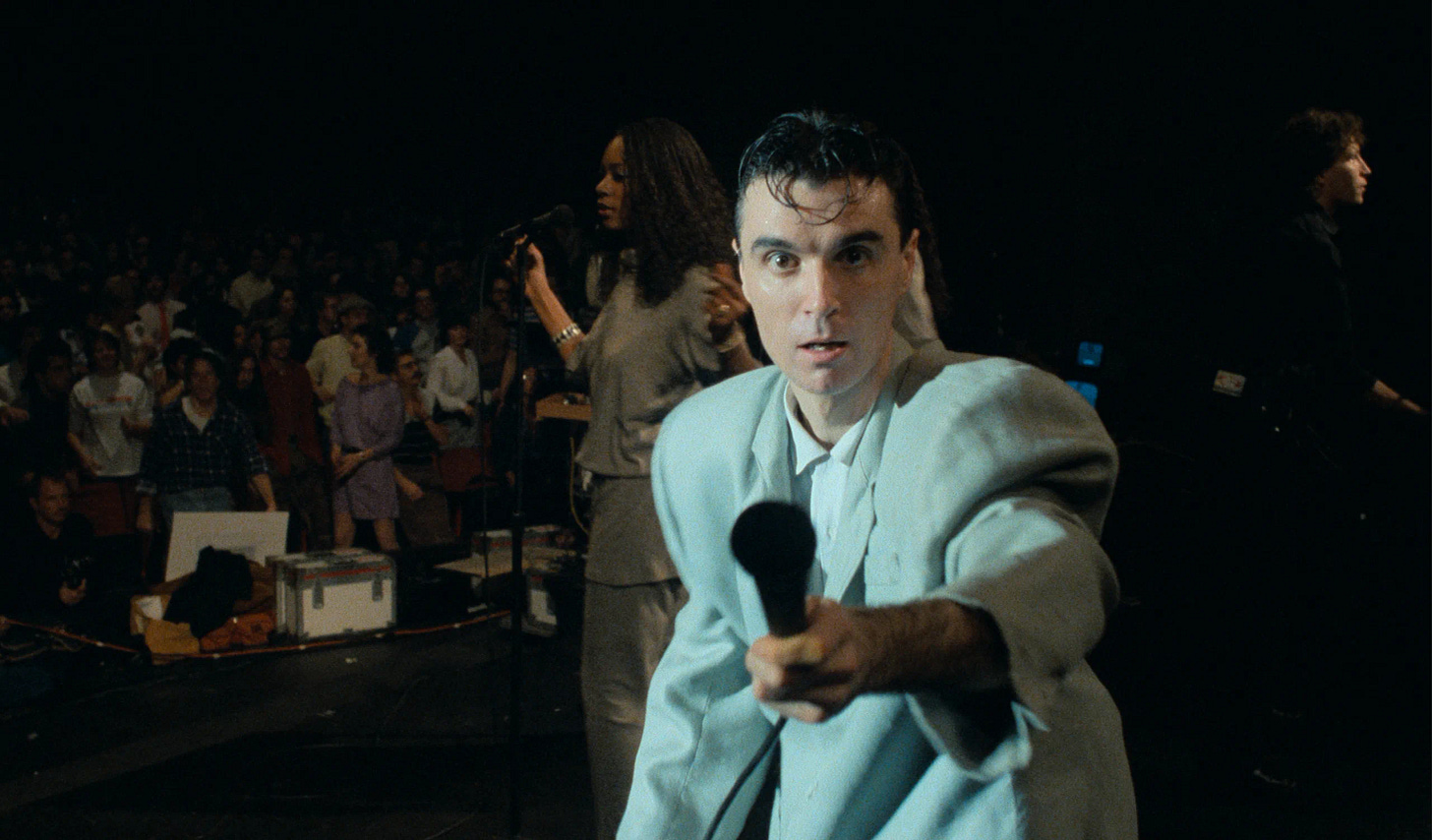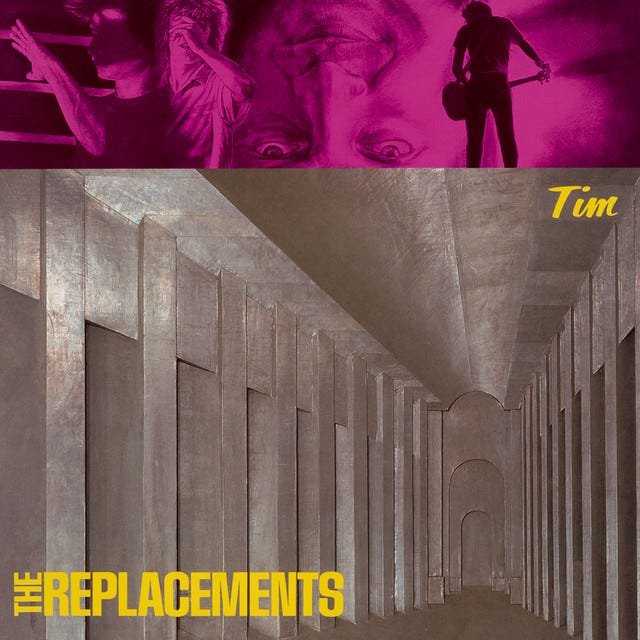Making sense of Talking Heads
A minimalist look wed to maximalist music makes a movie masterpiece (sorry, I've been reading James Ellroy). Plus, the Replacements, R.E.M., and 'The Bear'
I watched the re-released “Stop Making Sense” this weekend, and while there is no need for yet another review of the film, I did have a few thoughts as I watched and afterward. I didn’t trek to catch the IMAX version, but after watching this on VHS on a small TV when I was a teenager, this was a revelation.
Much of the discourse around the re-release of “Stop Making Sense” —other than that generated by the first appearance in the same room by all four members in two decades as they promoted it — is that it is one of the best concert films ever made, perhaps the best. Seeing it for the first time on a big screen, I'm hard pressed to argue the point. Everything about it is near perfect. Singer David Byrne, who came up with the concept, had a particular aesthetic in mind, and it works so well.
The impulse with music this vibrant would be to try to match that visually. Byrne knew this was unnecessary, would in fact be counterproductive. The music carries everything, and the austere production is the ideal setting. Only Drummer Chris Frantz's blue polo shirt and bad wedding DJ patter during the sore-thumb Tom Tom Club feature mar the presentation, and their presence only serves to drive home the well-crafted nature of the whole in contrast.
The other film usually mentioned in the same breath is "The Last Waltz" from The Band. There are similarities. Each was a highly choreographed performance filmed by a skilled auteur (Martin Scorsese and Jonathan Demme), and each caught a band at its end. That was more explicit in the case of The Band, of course, caught at the tail end of its career, but it was true of the Talking Heads as well, it just didn't know it yet. The band carried on for three more albums, even had a few minor hits, but everything that followed the film was on the downward slope from this high point.
One last parallel: Both also feature bands led by songwriters who thought they had exhausted the possibilities of those groups. Byrne and The Band's Robbie Robertson each embarked on solo careers that never reached the heights of what they left behind, and each spurned repeated requests from former bandmates to reunite.
I was never a big Talking Heads fan, more situational than devoted. This movie spent a lot of time in the VHS player when I was a teenager, and I loved The Name of this Band is Talking Heads, the band's previous live album. One LP captured them in 1977 and 1979, the other in 1980 and 1981. The first album (which comprised one side of a Maxell XLII cassette) spent the most time in the player, my ears favoring its angular guitar pop over the later forays into African rhythms and funk.
I tried listening to the reissued Stop Making Sense album a couple of weeks ago but switched to something else halfway through. Divorced from the visual of the band's performance, the music failed to grab me.
Having seen the film, I feel primed to give that soundtrack and the middle portion of the band's catalog — Fear of Music, Remain in Light, and Speaking in Tongues — a greater chunk of my time. Oddly, I came out of the theater wanting to hear Little Creatures, the studio album that followed this. I didn't crave hearing it so much as using it to better understand what happened. How could the band that created that film fall away from its sound so quickly? I didn't find an answer. Aside from the familiar hits — "And She Was," "Stay Up Late" and "Road to Nowhere" — I recognized very little and didn't feel compelled to keep listening. I actually like True Stories a bit more for the ragged charm of the performances, but’s a spotty album at best, and must admit I've never heard Naked in full, though I know it was a return of sorts to that earlier sound.
It was interesting to see the film again after so many years and be reminded of things. The biggest surprise was realizing how little Byrne actually wears the "big suit." It is the defining image of the concert, adorning the album cover and film poster, but he wears it for a song late in the set and sheds it during the next (the jacket, anyway. The pants stay put for the remainder). Again, there were gimmicks like this, but they were comic relief. Sure, it's funny watching Byrne dance with a lamp or jog laps around the stage, but the music going on around him is what keeps your attention.
I hadn't noticed until the end, but there are barely any of the crowd shots that are such a mainstay of concert films. You see the audience a bit at the beginning during Byrne's performance of "Psycho Killer," but it is not until the final song, "Crosseyed and Painless," that you see the typical shots of people dancing and singing along. Demme, in a 2007 interview, said that was because the light required to make such shots work was disastrous.
"The first night it was a total disaster," he said. "The more light we put on (the audience), the more inhibited they were. The more inhibited they were, the more insecure the band was, and I wound up being responsible for the worst Talking Heads performance in the history of the band's career."
In a film that captures the best parts of a four-night stand, he wound up also responsible for one of its best.
Thinking of Sting
One footnote: Watching this, I was surely the only person who thought of Sting, who I would guess watched this film and at least let it subconsciously inform the launch of his solo career. His post-Police debut, 1985's The Dream of the Blue Turtles, leans more on jazz than funk, but it features a band — including a backing singer in Dolette McDonald who performed with Talking Heads on its Remain in Light tour — that leans heavily on musical ringers to augment his sound. The concert film of the band's European tour, "Bring on the Night," feels very much of a piece with "Stop Making Sense," right down to having a respected filmmaker (Michael Apted, in this case), at the helm.
Let it be clear: Polished Mats a mixed bag
Thanks to Rhino Records’ inability to get something I ordered to me on release day, this is based on my first listen on Apple Music to the Ed Stasium remix at the heart of the new Tim (Let It Bleed Edition) boxed set.
A mea culpa of sorts: After publishing what comes off as a takedown of the new Replacements' box set for Tim last week, I will report that the new mix by Ed Stasium is growing on me. I still wish it had simply been a remix of what's there, and not an opportunity to unearth things that were not part of the original experience, but I'm beginning to appreciate the crispness of the performances. As I shared with friends after it hit streaming platforms and we all began to critique what we heard, I look forward to the day when we are sold the song files in a format that allows the listener to remix as each sees fit. Want to blast the reverb? Be our guest. Want to unearth every burp and blurt that made the producer thankful for the faders? Go crazy. That might even make me willing to part with my money for a fifth time for this set.
Back-to-back ballads
Listening again to Tim, coupled with hearing a podcast interview with R.E.M.'s Mike Mills where he discussed Automatic for the People, made me think about albums that sequence two ballads or quieter songs at the end of an album side. The Mats did it here with "Waitress in the Sky" and "Swinging Party," while R.E.M. did it twice. The first was on Fables of the Reconstruction with "Good Advices" and "Wendell Gee," and later on AFTP with "Nightswimming" and "Find the River." It's an interesting choice, all the more so on the R.E.M. albums, the second song in each pair almost like a bonus track. “We're not just ending with that one, but here's another one.” It's probably no coincidence that each pairing is among my favorite songs on these albums.
‘The Bear’ as playlist curator
I wrote about "The Bear" and the use of R.E.M.'s music a few weeks ago, and as my wife and I work our way slowly through this second season, I'm constantly amazed (perhaps "pleasantly surprised" is a better choice) at the songs that pop up. There is an aesthetic here, mostly Chicago-based, that feels genuine (even if most of the characters would be too young to know a lot of this). Watching an episode tonight from late in the season, I was taken out of the moment for a bit as I heard Eddie Vedder start to sing "Throw Your Arms Around Me." It's a gorgeous song, written by Mark Seymour of the Australian band Hunters & Collectors. One of my favorite bands, Crowded House, has often covered the song, fitting given that Seymour's brother, Nick, is the bassist in the band.
This version is from an Australian tribute album to Hunters & Collectors that features Vedder dueting with Crowded House frontman Neil Finn. It's a beautiful version that I would think of as fairly obscure here in the U.S. I found it easily enough on streaming platforms, so maybe the little geographical and stylistic niches that made things feel so special when I was younger are a thing of the past. Regardless, as I revel in "The Bear" not yelling at me quite as much this year (the Christmas episode contained enough to cover the entire season), I hope viewers are being turned on to some cool music in the process.





